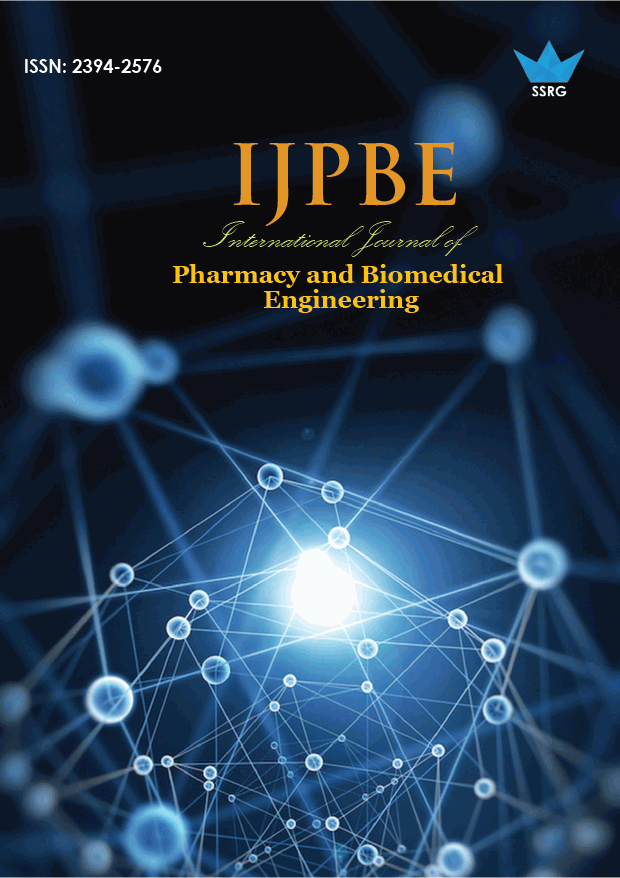Variation in Texture Features of Quadriceps Tendon with Different Body Mass Indexes

| International Journal of Pharmacy and Biomedical Engineering |
| © 2020 by SSRG - IJPBE Journal |
| Volume 7 Issue 3 |
| Year of Publication : 2020 |
| Authors : Mahdi Al-Qahtani |
How to Cite?
Mahdi Al-Qahtani, "Variation in Texture Features of Quadriceps Tendon with Different Body Mass Indexes," SSRG International Journal of Pharmacy and Biomedical Engineering, vol. 7, no. 3, pp. 1-3, 2020. Crossref, https://doi.org/10.14445/23942576/IJPBE-V7I3P101
Abstract:
In the present study, texture analysis and thickness were studied on the Quadriceps tendons (QT), to find the variation in image characterizing parameters and thickness among individuals having different Body Mass Index (BMI). Participants included in our study were all male, belonging to Saudi descent. Moreover, all had sedentary lifestyles and were not involved in physical activity or sports for the last six months. Nine volunteers were selected for the current study and were divided into three groups (weak, normal, and obese) according to their BMI. A total of 9 volunteers participated in the present study having a mean age ± SD, and BMI ± SD of 22.44 ± 0.53 kg/m2 and 23.53 ± 5.83 years, respectively. All volunteers having sedentary lifestyles and had the right side of their body as the dominant side. The results displayed that thickness increase with an increase in BMI, whereas, no particular or specific trend (increase or decrease) was found between the three different groups with different BMI for mean and variance values.
Keywords:
Quadriceps tendon, texture analysis, ultrasound
References:
[1] Lefebvre, F., et al., "Computerized ultrasound B-scan characterization of breast nodules". Ultrasound in medicine & biology, 2000. 26(9): p. 1421-1428.
[2] Materka, A.. "What is the texture". Texture Analysis for Magnetic Resonance Imaging, 2006: p. 11-43.
[3] Punys, V., et al. "Myocardium Tissue Analysis Based on. in Connecting Medical Informatics and Bio-informatics: Proceedings of MIE2005: the XIXth International Congress of the European Federation for Medical Informatics". 2005. IOS Press.
[4] Nicholas, D., et al., "Tissue characterization from ultrasound Bscan data". Ultrasound in Medicine and Biology, 1986. 12(2): p. 135-143.
[5] DaPonte, J.S., and P. Sherman, "Classification of ultrasonic image texture by statistical discriminant analysis and neural networks". Computerized medical imaging and graphics, 1991. 15(1): p. 3-9.
[6] Morris, D., "An evaluation of the use of texture measurements for the tissue characterization of ultrasonic images of in vivo human placentae". Ultrasound in Medicine and Biology, 1988. 14(5): p. 387-395.
[7] Goldberg, V., et al., "Improvement in the specificity of ultrasonography for the diagnosis of breast tumors by means of artificial intelligence". Medical physics, 1992. 19(6): p. 1475- 1481.
[8] Garra, BS, et al., "Improving the distinction between benign and malignant breast lesions: the value of sonographic texture analysis". Ultrasonic imaging, 1993. 15(4): p. 267-285.
[9] Chan, K., and K. McCarty. "Aspects of the statistical texture analysis of medical ultrasound images. In IEE Colloquium on Ultrasound Instrumentation". 1990. IET.
[10] Alqahtani, M., et al. "Tissue characterization: influence of ultrasound setting on texture features in vivo. In 2010 International Conference of Medical Image Analysis and Clinical Application". 2010. IEEE.
[11] Al‐ Qahtani, M., et al., "Body Mass Index and Segmental Mass Correlation With Elastographic Strain Ratios of the Quadriceps Tendon". Journal of Ultrasound in Medicine, 2019. 38(8): p. 2005- 2013.

 10.14445/23942576/IJPBE-V7I3P101
10.14445/23942576/IJPBE-V7I3P101